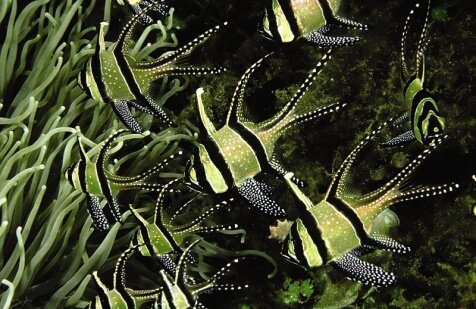Banggai Cardinalfish
From Microcosm Aquarium Explorer

Young wild specimen shelters near sea anemone tentacles. Alf Jacob Nilsen
Overview
The Banggai Cardinalfish is an excellent aquarium species, strikingly handsome and easy to keep, even for beginners. In smaller aquariums, it is best kept singly or in known pairs, as males will fight each other to the death if closely confined.
Mating pairs may become aggressive to tankmates, especially in smaller community settings. In a spacious community aquarium or a species tank, they are eyecatching and ideal reef fishes.
UPDATE: Many reports suggest that wild-caught Banggai Cardinals are prone to dying within weeks after being imported, apparently victims of a virus and/or bacterial disease.
Additionally, collection pressures on small wild populations may be putting this species at risk. It was listed as Endangered on the IUCN Red List of Threatened Species in 2007.
Captive-bred specimens are highly recommended.
Family: Apogonidae
Other common name(s):
- Highfin Cardinal
- Banggai Cardinal
- Kaudern's Cardinalfish
Native range:
Habitat: Open sandy bottom with seagrass beds, in bays or near reef. Associates with Long-spined Sea Urchins (Diadema setosum).
Maximum length: 7.5 cm (3 in)
Minimum aquarium size: 57 L (15 gal)
Water: Marine 24.4 °C (76 °F) - 26.6 °C (80 °F)
General swimming level: Mid-level
Feeding
Carnivore. Offer meaty foods, including chopped seafood, adult brine shrimp, Mysis shrimp and frozen preparations for carnivores. Live foods will help condition and help stimulate breeding behaviors.
Aquarium Compatibility
Easy to keep. Serious squabbles may occur in groups of Banggai Cardinals if housed in smaller tanks. A school may require a large tank (100 gal. or more).
Special Care
New specimens, unless captive bred, may refuse to eat and will become emaciated and perish. Feeding live adult brine shrimp for the first week is a good solution. Try feeding just before lights out at night, leaving a dim light burning in the room.
Gradually mix in frozen high-quality meaty foods, such as Mysis shrimp, and they will be weaned off live food. Live brine shrimp can be enriched by adding Selcon to their water for several hours before they are fed to fishes.
Breeding/Propagation
Mouthbrooder. Male carries eggs in his oral cavity and does not eat for a period of several weeks. Fry emerge fully pigmented and ready to eat baby brine shrimp (Artemia nauplii). Parents will eat young if they are not separated quickly.
See this article by Dr. Frank Marini for an account of early success breeding the Banggai Cardinal: Banggai Breeding I.
See also Matthew Wittenrich's Breeder's Guide to Marine Fishes (Microcosm/TFH 2007) for a full account of how to breed this and other cardinalfishes.
Notes
May be overfished in its remote wild range. Author Denise Tackett reports that a fish collector in Lembeh Strait, Indonesia, has released this species and it seems to be thriving and spreading.
Buy captive-bred specimens if available.
Originally introduced to the aquarium hobby by Dr. Gerald R. Allen, who "rediscovered" the species in a remote area of Indonesia in 1994 with underwater photographer Roger Steene.








